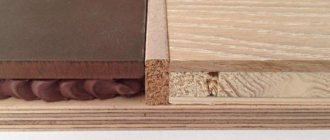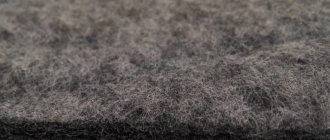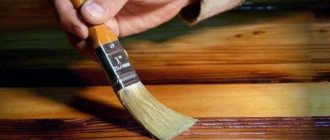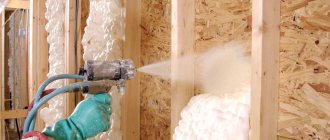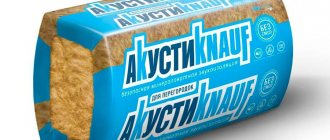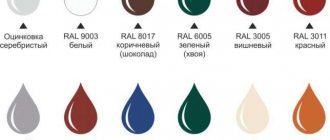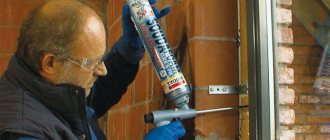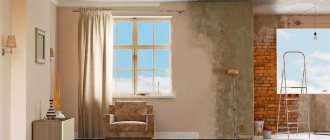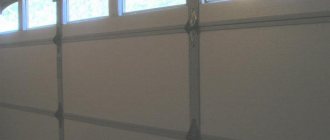Photo: Do-it-yourself soundproofing in an apartment. Author: Nikita Domov Comfort in an apartment can only be ensured if you can come to a warm house, protected from extraneous noises and sounds. Unfortunately, developers rarely use sound insulation when building houses; in most cases, walls, ceilings and floors transmit sounds well. It is for this reason that you can sit in your apartment and hear what your neighbors are talking about. How to soundproof a wall from neighbors cheaply and quickly with expert advice.
When a person comes home after a hard day at work, there is only one desire in his thoughts to relax. Extraneous noise interferes with good rest and sleep; in this case, the only correct solution is to soundproof the apartment with your own hands, and therefore significantly reduce costs. Today, thanks to various building materials, you can create effective sound insulation in your apartment, thereby providing yourself with peace and quiet.
There are two types of noise: airborne and structural or impact. If we talk about airborne noise, it usually occurs during a conversation, the TV is turned on loudly, or comes from the street. High-quality sound insulation will help reduce the volume several times, the main thing is to carry out all work processes correctly. As for structural or impact sound, it can be transmitted through hard surfaces in the form of vibration. Impact noise includes: the sound of a hammer, the operation of a power tool or household appliance. High-quality sound insulation of walls will help get rid of both types of noise.
The abundance of materials today is very large and it is possible to select sound insulation according to requirements, characteristics and cost. Cheap sound insulation is no longer a fantasy, but a reality. Every apartment owner tries to make effective sound insulation at minimal cost. Thanks to modern materials, you can make high-quality sound insulation with your own hands, without the help of specialists. This article will tell you where to start and how to do everything.
Photo: DIY frame sound insulation. Author: Nikita Domov
Process and processing features
To apply liquid sound insulation indoors, you need special technical equipment.
Under pressure, the chemical composition is applied to the surface, forming a polyurethane layer. Such insulation will protect the house from noise, cold penetration and various pests. The work process is simple. If working with other materials requires certain preparation, then in the case of polyurethane foam, all this is not needed. If there are large peeling elements on the surface of the wall, then they can be dismantled, but otherwise nothing is needed.
Application technology
The technological process of applying sound insulation has some similarities with painting. Liquid noise insulation must be applied evenly, like regular paint in several layers. Do not hold the sprayer at one point for a long time to prevent large foam formation. The thickness of the layer should be three centimeters, this is enough for the material to provide the necessary level of protection.
Stage 1. Preparatory
There is no preparatory stage as such when treating with liquid sound insulation, but you can clean the wall surface from peeling elements. It also doesn’t hurt to cover the floor with plastic film or paper. Foam that gets on the floor will dry out and be difficult to clean.
If there are wires and sockets on the wall, then they should be covered first so that in the end you do not have to completely change the wiring. A special corrugated casing should be used for cables. Upon completion of the preparatory work, equipment is brought in and application can begin.
Stage 2. Primer
The surface of the wall should be treated with a primer. As with any finish, the primer provides maximum adhesion to the coating. You can apply the primer either with a hand tool: a roller or brush, but also with a spray gun. Liquid impregnation of walls is a prerequisite when working with surfaces.
@zhidkaya_shumoizolyatsia
Thanks to the primer, fungi or mold do not form on the surface of the wall under the sound insulation. The primer must be applied evenly over the entire surface. It is better to start applying from the top of the room, this way you will not get smudges.
Stage 3. Applying sound insulation
Polyurethane foam must be applied in two stages. The first layer is thin for the binder, and the second is denser. It is during the application of the second layer that a reliable soundproofing coating is formed. The polymer expands, and the resulting bubbles will be an excellent insulating layer. When working with polymer, a special pressure-operated tool is used. When the insulation layer has reached three centimeters over the entire surface, you can finish processing and put away the equipment.
Stage 4. Drying
After completing the application of the polymer material, it must be allowed to dry. Depending on the manufacturer and composition of the foam, drying time may vary. When sound insulation hardens, it forms a dense porous structure. The outer surface of the coating is uneven, so to bring the wall to perfection it is necessary to use facing slabs or panels. As an option, you can use decorative panels, which, despite their small thickness, also have a certain level of sound insulation. When all finishing and installation work is completed, the object can be handed over to the owner.
Today, the variety of soundproofing materials is so great that you can choose according to your requirements and wishes. When it comes to a large apartment, using frame sound insulation in it will be beneficial for you, since its cost is cheaper than using liquid sound insulation. Liquid sound insulation of the floor in the apartment, as well as the walls and ceiling will make the room comfortable and convenient. The optimal treatment option is considered to be a small living space. Thanks to the insignificant thickness of the soundproofing layer, those important centimeters will be preserved in the apartment.
As stated earlier, only an integrated approach to sound insulation guarantees effective and reliable protection from various noises and sounds. By installing external and internal sound insulation in your apartment, you don’t have to worry about your sleep and peace of mind.
About the features of liquid insulation.
Liquid car insulation is an excellent way to eliminate unwanted noise during car operation, where its analogue is powerless. Thanks to its liquid structure, you can easily isolate areas of the car that are difficult to access. This type of insulation eliminates sounds coming from the bottom of the car or wheel arches. This means that if stones or other interference gets into these places, there will be no unnecessary noise in the cabin. The insulating mixture is based on liquid rubber, which muffles noise from the inside. In addition to its main role, sound insulation has a number of useful properties. It prevents moisture from entering the metal surface, reliably protecting the material from unwanted influences. Thus, the surface of the car retains its structure longer, extending the life of the car.
liquid sound insulation
Typically, this product is used to coat the interior surfaces of the car. Unlike insulating material, liquid car sound insulation repels moisture, thereby prolonging the insulation effect. Analogue, quickly absorbs moisture and begins to conduct sound. This is one of the advantages of the new type of insulation.
Today, there are several types of liquid sound insulation. Depending on the type of application of the product to the surface, two insulations can be distinguished.
In the first, an insulating agent is applied to the surface, together with the primer. This creates a more solid foundation for the insulation layer.
The second type is applying the product to a cleaned surface.
Professionals, I recommend combining the usual material for car insulation, together with a liquid insulator. A liquid product that does a good job of eliminating noise in bumps and depressions of the body. One of the positive properties of liquid material is protection against impacts and scratches. Rubber coating prevents destruction of metal surfaces. Thanks to this property, the liquid is very important for insulating the bottom of a car.
If we emphasize the advantages of a modern analogue of car insulation, we can highlight the following qualities:
- Simplicity and ease of use.
- Ability to isolate hard-to-reach areas of the car.
- Useful properties (moisture repellent and shock protection).
- Good noise suppression during machine operation.
- Improving the sound of acoustics.
- Preventing car trim noise.
Soundproofing plaster
Sound insulation can be ensured not only through the use of paints and varnishes, but also through soundproofing plaster. The composition of the plaster includes special components, the presence of which ensures insulation from sound influences. We are talking about fillers in the form of small 5 mm granules. Expanded clay or pumice is most often used as a material for granules. Moreover, the granules are lightweight because they have a hollow structure.
Aluminum powder can also be added to the soundproofing composition. When such a powder goes through the drying stage, gas is released from it, which ensures the porosity of the material. The loose structure allows the propagation of sound to be delayed, since the waves are repelled by very small particles.
Note! There is a misconception about the inability of plaster to act as sound insulation. In fact, a plastered surface can absorb a significant part of the sound wave, but only if the composition was applied in compliance with the technology
It is not recommended to paint a plastered wall with thick paints and varnishes such as enamel, since such actions lead to the loss of a significant part of the soundproofing properties. The fact is that thick compositions fill the small pores of the plaster, which negates all the advantages of the porous material. In addition, you should not cover the plaster with wallpaper, since the glue (viscous substance) also clogs the pores.
Plaster is an environmentally friendly material, so it can even be used in children's rooms. In addition, relief-plastered walls look very decorative, making them pleasing to the eye and can, in addition to their utilitarian function (protection from noise), play the role of interior decoration.
Applying plaster
Before applying acoustic plaster, the surface must be carefully prepared. To do this, you need to level the wall, remove dirt and dust from it, and apply a primer.
Note! The primer will adhere better to the wall if you add ten percent lime paste to it. When the primed surface is dry, you can apply the plaster composition
It is important that the surface remains smooth after plastering, and the layer of material does not exceed 2-3 centimeters
When the primed surface is dry, you can apply the plaster composition
It is important that the surface remains smooth after plastering, and the layer of material does not exceed 2-3 centimeters
If there is a high probability that the working day will end faster than the entire surface is covered with acoustic plaster, it is recommended to make a layer 1/3 thinner than necessary. In this case, work will continue by applying a new overlapping layer. If you immediately apply an even layer and do not complete the work, then in the future there will be unsightly joints visible to the eye.
Once the plaster is applied, it is not recommended to grout the layer. Instead, it is better to treat the surface with a trowel. If you plan to paint the wall, it is recommended to use only water-dispersed paints: although applying paint is not advisable at all, water-based paints are least likely to harm the sound insulation properties of the material.
Soundproofing coatings or plaster by themselves are not able to completely protect premises from noise, since this requires a set of measures that use a number of materials. However, as an additional measure, the soundproofing composition will certainly improve the sound insulation performance.
What is the essence of liquid sound insulation?
Liquid sound insulation is a material that is applied to the surface of a wall, floor or ceiling to provide protection against the penetration of various noises and sounds. As is known today, noise is divided into two main types:
- Air;
- Vibrating.
Airborne noise refers to sounds that are transmitted through the air. Airborne sounds include: a loud TV, a conversation heard from neighbors or sounds coming from the street. To absorb airborne noise, a soft and porous surface of a soundproofing material is required, which, due to its structure, absorbs some of the waves and makes it quite acceptable.
Vibrating sounds are mainly caused by the operation of electric tools or household appliances. Such noise can be transmitted over hard surfaces, and to protect against it, special vibration pads and other elements are needed.
It is worth noting that among all insulating materials there is practically no product that could simultaneously and with the same performance retain both types of noise. Some materials are porous and soft, others, on the contrary, are knitted and elastic. The only insulation option that combines two types of insulation is liquid Shumka.
Despite the fact that this material only recently began to appear on the market, it has already managed to attract the attention of many buyers. It is worth noting that due to its soft structure, after drying, the composition hardens and forms a so-called vibration barrier, which does not allow noise and sounds to pass through. The composition is sold in liquid form and applied to surfaces three centimeters thick
A small layer of material is guaranteed to provide effective protection against sound waves. After drying, the soundproofing of the walls in the apartment has a lumpy surface, so it cannot be used as a finishing material; it must be covered with plasterboard or chipboards
The composition is sold in liquid form and applied to surfaces three centimeters thick. A small layer of material is guaranteed to provide effective protection against sound waves. After drying, the soundproofing of the walls in the apartment has a bumpy surface, so it cannot be used as a finishing material; it must be covered with plasterboard or chipboards.
Styrofoam
This material is often used for sound insulation. Its advantages:
- easy;
- accessible;
- environmentally friendly;
- comfortable in using;
- can be formed, cut and processed.
The walls are lined with polystyrene foam. The material releases volatile substances in very low concentrations, so it does not harm health. In exceptional cases, individual intolerance to polystyrene foam is observed.
Thanks to its porous structure, the material effectively absorbs vibrations. If you install soundproofing boards correctly, you will be able to reduce the noise level. Polystyrene foam has good functional characteristics. It is light in weight, which means it is easy to transport.
The slabs can be stored for a long time in an unheated room, they will not deteriorate or lose their properties. Foam plastic has a low melting point, regular foam melts at a temperature of + 145 degrees, and epoxy at a temperature of + 170 degrees. Lights for 4 seconds, after which it goes out if there is no source of fire nearby.
Features of fine sound insulation
Membranes are convenient because they take up little space, but at the same time isolate sounds very effectively.
Recently, thin sound-proofing materials have become quite common, which provide protection without loss of living space.
They are called soundproofing membranes. Their installation can be done not only on walls, but also on the ceiling, partitions or floor.
Thin wall sound insulation has a number of significant advantages:
- The thickness of the product is only 3.7 mm. The material is able to provide maximum sound insulation with minimal loss of space.
- There are practically no other protection options with the same effectiveness.
- The product is made from environmentally friendly components. The composition does not contain bitumen and rubber. The material itself is quite durable and has an increased service life. It is these characteristics that have ensured such popularity of membranes.
- Installation of the products is quite simple, even a person who does not have construction skills can handle it. A structure is created whose thickness does not exceed 5 cm. In this case, the noise level will be reduced by approximately 70%.
Installation of the membrane begins with the installation of the frame.
To install the membranes, you will need to build a metal frame, its fastening will be carried out using direct suspension.
This is what will save most of the space. The procedure for this is as follows:
- the frame is being built;
- slabs based on mineral wool are laid in it;
- the membrane is stretched;
- the structure is covered with a sheet of plasterboard. For more information about modern soundproofing materials, watch this video:
The length of 1 roll of membrane is 5 m and the width is 1.25 m. The weight of 1 m² of material is approximately 8 kg.
Correct frame sound insulation - design, installation
In the usual case, to manufacture a high-quality soundproofing system, the following components will be required:
- galvanized metal profile for frame assembly;
- vibration suspensions, crabs, other fasteners;
- damper tape for gluing the joints of the panel with the floor, ceiling and walls. It is also pasted over a metal profile to eliminate sound bridges;
- mineral slabs or other fibrous filler with a density of at least 40 kg/m3;
- sheets of plasterboard (GKL) or gypsum fiber (GVL) for sound-reflective cladding.
Installation of high-quality sound insulation in a new building begins with marking the surface, after which the craftsmen begin cutting the galvanized metal profile (wooden beam) and assembling the frame. The best way to install the structure is in spacers. In this case, the load-bearing capacity of the system is formed due to the support of the frame elements in the building structures adjacent to the insulated surface. This technology provides maximum acoustic isolation between the wall and sound insulation.
Due to the relatively high mass of frame systems (the weight of one square meter can reach 30 kg), installation in a spacer is unacceptable for soundproofing ceilings. Here it is necessary to use vibration suspensions, which are fixed to the interfloor ceiling, ensuring reliable fastening of the frame. The special design of these parts does not allow vibrations of building structures to be transmitted to the elements of the noise insulation system.
When the frame is mounted and secured, the formed cells, as well as the voids of the galvanized profile, are filled with fiber filler. The external surfaces of the load-bearing elements are glued with damper tape. GV or GK sheets are attached to the frame with self-tapping screws, the joints and seams are filled with sealant. This completes the assembly of the soundproofing structure. You can move on to finishing: putty, primer, painting or wallpapering.
Liquid sound insulation for internal treatment
Bituminous mastic is not suitable for internal use, but there are materials that will protect the house from noise and save heat much more effectively. Sprayed polyurethane foam is the best sound insulation option for a small apartment. It is worth noting that with a thickness of only three centimeters, the layer effectively retains both airborne and vibration noise.
To treat the surface of a wall or ceiling, no special preparation is required; it is enough to clean the area being treated of peeling elements and you can get to work. In terms of time, such processing will take about three hours, provided that a highly qualified specialist works. Polyurethane foam is applied using special equipment, so it is impossible to do without the involvement of specialists. Not every home has a gun for liquid insulation, so it’s worth turning to the experts.
After the soundproofing is applied, it needs to dry. After final drying, the surface is covered with sheets of plasterboard or other decorative elements.
Rubber bitumen mastics
Rubber-bitumen mastic is used as waterproofing. Due to the chemical composition of the substance, mastic can be used to treat various surfaces. Of course, mastic can only be used as sound insulation in a car, and as for an apartment, it is not necessary, but if it is necessary to carry out work to protect the surface from aggressive environments, it is one of the best.
@zhidkaya_shumoizolyatsia
Using rubber bitumen mastic, external sound insulation can be carried out. Quite often, rubber bitumen mastic is used for various types of roofs. Due to its characteristics, the material provides hydro and sound insulation, but this applies mainly to upper floors and apartments.
Useful tips
These tips should be taken into account at the preparation stage, during direct application, as well as after treating the car with liquid soundproofing materials. There is nothing complicated about them, but this way you will know for sure that you are doing everything right.
- Always shake cans and mix liquid formulations before application. Liquid rubber is a multicomponent product, some of the additives in which can gradually settle to the bottom. As a result, the insulator turns out to be broken into layers, when applied, not all properties can be obtained, or the effectiveness of protecting the metal can be reduced;
- Use of sprayers. If sound insulation is presented in the form of a spray can, such a product should be applied evenly and smoothly. Don’t rush anywhere, otherwise you only risk ruining everything. Never hold the cylinder against one point for a long time, but also avoid areas of metal surfaces. A layer that is too thin will not cope with the load, and a layer that is too thick will take a long time to dry;
- Protection of car elements. Since liquid rubber is not applied to all surfaces, they must be protected from contact with the product. Use duct tape or wide tape. After completing the work, carefully remove them;
- Read the instructions. The advice is banal, but for some reason it is the one most often ignored by motorists. No one disputes that many drivers previously had to work with liquid soundproofing materials. But each manufacturer has its own characteristics, characteristics and properties, uses different additives, which is why there are no universal instructions for use. You need to carefully read the manual for a specific liquid insulator in order to avoid mistakes and make the most of the material’s capabilities;
- Combination of traditional and liquid insulators. In fact, this is the best solution that can be made if you want to create the highest quality sound insulation;
- Degreasing. This is the moment when not all manufacturers can be trusted. Some of them write on the packaging of their liquid rubber that there is no need to pre-degrease the surfaces, since their composition will cope perfectly well without this preliminary preparation step. It is possible that this is so. But it’s better to play it safe by using degreasers. If the rubber does not adhere tightly to the metal surface, the layer may swell and peel off, which ultimately triggers the formation of corrosion. Plus, the quality of the sound insulator itself will decrease;
- Do not disturb the drying mode. Drivers often see that the insulator has dried out already on the second day, so they hurry to get behind the wheel and check the performance of the liquid sound insulation in action. A very common and serious mistake that is not recommended. Even if it feels like the tires are completely dry, when you need to wait 4 days, wait the full 4 days. And only then can you drive the car out of the garage.
Each car owner decides for himself whether to carry out noise insulation with liquid means himself or turn to a car repair shop for help. The main thing here is not to skimp on quality materials, and also to follow all the rules for preparing a car for applying liquid sound insulation. Then the time and financial costs can be fully justified.
Types of liquid soundproofing materials
Today, manufacturers of liquid sound insulation offer customers various types of material, which can be selected according to manufacturer, characteristics and cost. Polyurethane foam materials are produced in different countries, which determines their type, efficiency and price. Among the most common are the following:
- Polyurethane foam Synthesia this material is produced in Spain. The main advantage of sound insulation is its reasonable cost in relation to quality. The material is made from environmentally friendly ingredients, so it can be used for processing in residential areas. Also among the positive qualities of foam is the fact that it can be used at different temperatures.
- Ecotermix polyurethane foam sound insulation is a product of joint production between Russia and China. The material can be used in various rooms and has a high level of fire resistance. This sound insulation also protects wall surfaces from biological formations of fungus and mold. Speaking about the cost of foam, it can compete with products from other manufacturers.
- Demilec polyurethane foam material is manufactured in the USA. This product can be classified as a top-class product, as evidenced by its high quality, reliability and cost. The effectiveness of sound insulation is quite good, but not everyone can afford it.
- Bayer polyurethane foam is produced in Germany and is already a fairly well-known brand throughout the world. As always, the consistent German quality and relatively low cost of the material make it popular among buyers. If you need to perform high-quality sound insulation at a relatively low cost, then the Bayer brand provides its product.
@zhidkaya_shumoizolyatsia
Depending on your budget, you can choose the most suitable soundproofing option, which will help protect your apartment from noise and at the same time save money.
Reference data
To make it easier for you to navigate when deciding whether to soundproof an apartment in a panel house, we provide data on the Rw values of building structures made of various materials, the requirements for sound insulation of various rooms and the level of noise created in everyday life by various sources.
Rw value for the most common materials used in construction
| Installation material and format | Thickness in mm | Rw, sound insulation index | Application area |
| Brick (one and a half bricks) | 380 mm | 56 dB | External and load-bearing walls |
| Brick (one brick masonry) | 250 mm | 54 dB | External walls, inter-apartment partitions |
| Brick (half-brick masonry) | 125 mm | 47 dB | Apartment and interior partitions |
| Hollow-core reinforced concrete slab with a thickness of 22 | 220 mm | 52 dB | Interfloor ceilings |
| Vibration-pressed reinforced concrete floor slab 16 | 160 mm | 52 dB | Interfloor ceilings |
| Vibration-pressed reinforced concrete floor slab 14 | 140 mm | 51 dB | Interfloor ceilings |
| Monolithic reinforced concrete | 200 mm | 53 dB | Support frame |
| Monolithic reinforced concrete | 250 mm | 55 dB | Support frame |
| Gypsum concrete panel | 80 mm | 40 dB | Bathroom box |
| Foam block D400-15 | 150 mm | 41 dB | Apartment and interior partitions |
| Foam block D400-12 | 120 mm | 40 dB | Apartment and interior partitions |
| Foam block D400-10 | 100 mm | 39 dB | Apartment and interior partitions |
SNiP 23-03-2003 requirements for sound insulation of some premises
| House category | Minimum required Rw, dB | Impact noise level Lnw, dB (for floors) |
| Overlappings between apartment premises and separating apartment premises from staircase halls and used attic spaces | ||
| Category A | 54 dB | 55 dB |
| Category B | 52 dB | 58 dB |
| Category B | 50 dB | 60 dB |
| Floors between apartments and shops located underneath them | ||
| Category A | 59 dB | 55 dB |
| Category B, Category B | 57 dB | 58 dB |
| Floors between rooms in an apartment on two levels | ||
| Category A | 47 dB | 60 dB |
| Category B | 45 dB | 63 dB |
| Category B | 43 dB | 66 dB |
| Overlappings between apartment premises and restaurants, cafes, and gyms located underneath them | ||
| Category A | 62 dB | 55 dB |
| Category B, Category B | 60 dB | 58 dB |
| Floors between apartment premises and administrative premises and offices located underneath them: | ||
| Category A | 52 dB | 58 dB |
| Category B, Category B | 50 dB | 60 dB |
| Walls and partitions between apartments, between apartment premises and staircases, halls, corridors, lobbies: | ||
| Category A | 54 dB | — |
| Category B | 52 dB | — |
| Category B | 50 dB | — |
| Walls between apartments and shops: | ||
| Category A | 59 dB | — |
| Category B, Category B | 57 dB | — |
| Partitions between rooms, between the kitchen and the room in the apartment | ||
| Category A | 43 dB | — |
| Category B, Category B | 41 dB | — |
Liquid sound insulation
Liquid polyurethane foam fills all the smallest cavities well.
Liquid sound insulation of walls is carried out by spraying polyurethane foam. This material has good sound insulation properties. The liquid mixture for walls fills almost any hole, while creating a layer of monolith that prevents the penetration of unnecessary sounds. After hardening, the foam does not have much weight, so there will be no unnecessary load on the coating.
Liquid sound insulation of the walls in the apartment will also protect against rodents and many insects. The polymer can be applied without preliminary preparation; the construction of a frame is also not required. During operation, a minimal amount of contamination is generated. The service life of the foam is extremely high; the coating can last up to 50 years. For more information about finishing walls with polyurethane foam, watch this video:
The only disadvantage of this method is the need to use a professional tool. There is no particular point in purchasing it; the best option is to call a specialist. The cost of such treatment is approximately 1500-2000 rubles for 1 m².
In the following table you can see the sound absorption rates of various materials.
Advantages of liquid sound insulation
Foam has high adhesion to all types of surfaces.
Liquid sound insulation solution has the following advantages:
- After treatment, the wall acquires excellent heat and sound insulation properties. This will not only get rid of extraneous noise, but also save on heating.
- The polymer is able to penetrate into the smallest cracks, which will allow you to process openings in doors and windows. This procedure, in addition to soundproofing, will help you forget about drafts.
- High adhesion to surface. There is no need to install the lathing; the polymer can also be applied to the ceiling without prior preparation. After work, a minimal amount of contamination is formed.
- Possibility of complete sealing of the room. After processing, a monolithic layer is created that will fill all the holes between the structures.
- Lightness of the material. The hardened foam has minimal weight, so there will be no load on the load-bearing elements of the home.
- Thanks to its structure consisting of small cells, sound insulation allows you to suppress sound waves over a wide range.
Types of polyurethane foam for liquid sound insulation
The Russian-Chinese material has quite affordable prices.
There are quite a large number of varieties of polyurethane foam.
This material is manufactured in different countries, the types differ in their effectiveness and, of course, cost.
The most common options are the following:
- Synthesia polyurethane foam. Produced in Spain. The main advantages include reasonable cost, environmental friendliness and the ability to use at any time of the year at any temperature.
- Ecotermix. Manufactured by China together with Russia. The material has a high level of fire resistance and is able to provide protection against the formation of mold, mildew and other bacteria. The cost of such products compares favorably with its main competitors.
- Demilec polyurethane foam. Manufactured in the USA and belongs to premium soundproofing materials. It is the highest quality and most reliable solution for protection against extraneous noise. The only drawback is the high cost, but you have to pay extra for quality.
- Bayer polyurethane foam. It is a reliable solution from a German brand. The product quality is at an acceptable level; spraying is carried out using a special device. For more information about the components for the production of polyurethane foam, watch this video:
As can be seen from the article, liquid sound insulation is the optimal solution for protection against extraneous noise. This processing option allows for maximum protection efficiency, while the service life of the product is at an extremely high level.
The most obvious purpose of paint or plaster when applied to the walls of a house is to give the surface a more attractive, updated look. However, this is not the only task of the finishing material.
It is equally important to protect the base material and residents from adverse environmental influences. For example, you can protect yourself from noise using soundproofing paint and plaster.
Other types of insulating materials protect against moisture and electrical current. This article will discuss the types and features of the use of insulating materials.
Areas of application
Insulating materials can be used to protect buildings of various types - not only residential, but also for technical purposes. Insulation can protect the room from excessive humidity, electric current and noise exposure.
Moisture protection
The issue of waterproofing is one of those problems that can be solved with the help of paint and varnish material. It should be noted that most paints, one way or another, have waterproofing properties. However, if you need truly serious protection, you cannot do without a special coating. After coating with this composition, the surface will withstand even direct exposure to water for a long time.
Waterproofing coatings must have certain qualities:
- The paint should be intended for both interior work and facade finishing, since double-sided painting provides more reliable protection.
- It is desirable that, in addition to moisture resistance, the paintwork material is resistant to ultraviolet rays and temperature changes.
- The composition should include anti-salt additives and antifungal drugs. Antiseptic qualities are very important for good waterproofing, because moistened material is an ideal place for the development of mold and mildew.
Note! The quality of the paint and varnish material is influenced not only by its shelf life, but also by storage conditions. The paint should not be in too cold rooms (at sub-zero temperatures) or too hot
Information on storage times and conditions can be found on the product packaging.
Noise insulation
An increased level of sound insulation can be achieved by painting the surface with special paint. Soundproofing coatings have a number of characteristic features:
The basis of this type of paint is bitumen or an acrylic composite element. Both substances have a number of features: acrylic is better suited for interior work, since it is practically odorless (water-based), and bitumen is much more effective outdoors, but is not suitable for indoors, as it smells unpleasant
At the same time, bitumen coatings are much cheaper than acrylic ones, which is important when painting large areas. The maximum level of sound insulation can be obtained if the composition is applied in a thick layer. It is recommended to use a brush or roller as a working tool
The paint dissolves in a synthetic composition. For insulating moving elements (for example, machine or car parts), bitumen-based paints and varnishes are best suited. This group of paints is capable of absorbing not only sounds, but also vibrations.
Drywall
To create reliable sound insulation, you need to choose a material of high density. Drywall, designed to suppress sound vibrations, contains special membranes and mineral wool. To enhance the sound insulation effect, many sheets should be laid. To make a sound-absorbing structure, you need to use 2 sheets of gypsum plasterboard or use a combination of gypsum plasterboard + gypsum plasterboard.
Drywall can withstand significant loads. It is fire resistant and not susceptible to moisture. The material can be formed and does not crumble. For high-quality insulation, exclusively dense plasterboard is used.
